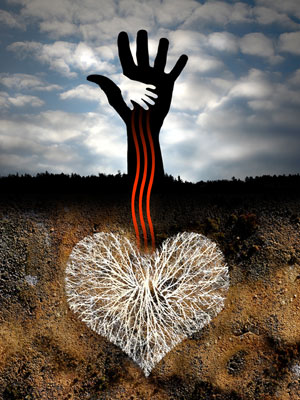Contributed by Jay McDivett, Mequon, WI
Warm-up Question
Tell a story about one of your scars. Or, if you don’t have any (or it makes you uncomfortable), tell a story about a childhood injury that you remember (what happened, how long did it hurt, etc.).
Scars That Heal
On April 2, One Goh, a former student at Oikos University, a small Christian school in Oakland, CA, shot 10 people, killing 7, in a place that had been known as a safe place for immigrants to begin a new life and a new career in the U.S.A. While the student body is largely Korean, the victims Goh murdered – execution-style – were from all over the world.
Since then, details have emerged that Goh was upset over being expelled from the school, as well as being teased for his grasp of the English language. He may also have had difficulty getting along with women. Regardless of his motivation and/or mental state, the result has devastated this school, the city, and its many immigrant communities.
And so, as Christians everywhere began to celebrate Holy Week, with its re-telling of the story of Jesus’ journey to the cross and grave, the Oikos tragedy serves as yet another reminder that violence, exclusion, bullying, execution, and the complicated lives of immigrants living in a foreign culture (all of which are present in the Holy Week stories) are not a thing of the past. These are new wounds opened up in a Christian community that must wrestle with the reality of death in the midst of a season that promises life.
Discussion Questions
- How do you understand events like the Oikos tragedy in terms of your faith? What questions do these headlines raise for you?
- Could something like this ever happen at your school? Why or why not?
- How should One Goh be treated by the families of the victims, the community, the church, and the justice system? What would you want to see happen to him if you were a part of the community affected by his actions?
Scripture Texts (NRSV) for Sunday, April 15, 2012 (Second Sunday of Easter)
Acts 4:32-35
1 John 1:1–2:2
John 20:19-31
(Text links are to Oremus Bible Browser. Oremus Bible Browser is not affiliated with or supported by the Evangelical Lutheran Church in America. You can find the calendar of readings for Year C at Lectionary Readings.)
For lectionary humor and insight, check the weekly comic Agnus Day.
Gospel Reflection
Last Sunday, we celebrated God’s victory over death with the festival of the Resurrection. Most churches pull out all the stops on Easter Sunday. Lots of regulars, visitors and occasional church-goers (what some call “Christmas and Easter” or “C&E” folks) dress in their Easter finest and are treated to festive music, beautiful decorations, egg hunts, lavish breakfasts… It’s a festive day. And why not? We are, after all, “Easter people.” We live by the story of the resurrection. As baptized people, we are joined to Jesus in his death so that we might be joined to him in his eternal and abundant life as well. This is good news!! It deserves a joyful noise, a beautiful day, a festival.
And yet, every year, the Sunday after Easter always features another story, the story of unfairly named “Doubting Thomas” longing to see Jesus’ scars. Imagine that. The lesson for almost every other Sunday in the church year changes from year to year in the three-year lectionary cycle, the Second Sunday of Easter always tells a story about doubt and scars. Why?
There are many reasons, to be sure, but perhaps the most meaningful is this:  The church knows full well that while the Resurrection declares God’s final and total victory over sin and death, most of the world – including, of course, most Christians – are still living in a world full of violence and tragedy, hunger and poverty, brokenness and sorrow. It is sometimes hard to hold onto the victory of Easter in one hand while holding a newspaper, smartphone, Facebook, or Twitter feed in the other. In public and private ways, Christian lives are still mired in all the stuff that Jesus came to destroy.
The church knows full well that while the Resurrection declares God’s final and total victory over sin and death, most of the world – including, of course, most Christians – are still living in a world full of violence and tragedy, hunger and poverty, brokenness and sorrow. It is sometimes hard to hold onto the victory of Easter in one hand while holding a newspaper, smartphone, Facebook, or Twitter feed in the other. In public and private ways, Christian lives are still mired in all the stuff that Jesus came to destroy.
That kind of thing can make a person begin to doubt. 2000 years later, the Easter story (and the Church which bears this story on its lips) has yet to vanquish all the pain and suffering we live with. Indeed, it often feels like things are just getting worse.
So what do we do with this reality? How do we celebrate the resurrection while also being honest about the world of woe in which so many of our neighbors and ourselves are living in? Thomas gives us some great keys to living with this mystery:
- Stick around: This story takes place over the course of two weeks – or, at least, two weekends. For a reason known only to God and him, Thomas missed the first appearance of Jesus in the upper room (maybe because instead of huddling in fear behind locked doors, Thomas alone was brave enough to go out in the streets and keep on doing the work Jesus called the disciples to do…). Missing out made him ask for the same proof that the rest of the disciples literally got handed to them, the scars. But his doubt and questions didn’t make him give up. Instead, he shows up to worship again the next week—and meets Jesus meets. While it’s great to have lots of people show up for Christmas and Easter, we miss a lot if we only show up for the glitz and glory. Every week, Jesus walks through locked doors and shows us the signs of his love with his own broken hands. Keep showing up. Stick around.
- Ask tough questions: Church is not a place for people who’ve got it all figured out. Church is a place for people who live with doubt and questions. Everyone doubts and questions – ask your pastor and she’ll tell you, even (or especially) pastors have doubts. But even when it’s hard to believe, we believe that the gift of faith is a gift given to a community – to a family of broken, doubting, fearful people who are all desperate to hear a word of hope in the midst of a world that seems to be falling apart. We’re in this together, but we don’t get far when we pretend we’ve got it all figured out. Bring your questions to church. You’re in good company.
- Look for the scars: Barbara Lundblad, an ELCA pastor and professor, asked some great questions about this text in a sermon: Why does Jesus have scars? If God could raise Jesus from the dead, why couldn’t God fix him up and take away his scars? What’s in the scars? It seems that the scars, far from being a mark of shame, are actually signs of life: The scars tell us that Jesus was exactly who he said he was, the Word made flesh. Jesus is a real human being. Jesus knows in his own flesh and blood the pain and suffering of being alive in a broken world. Jesus is God close enough to know exactly what people like you and me are going through. And Jesus knows that even after the resurrection, there are still open wounds longing to be healed. The scars tell us that Jesus is still in the middle of it all. Jesus wears on his own body the marks of a world gone mad, and Jesus will not stop living and loving this world with his whole self until every open wound has been touched by the grace of the living God.
Scars are holy. They tell stories about where we’ve been, how we’ve been hurt, and what it takes to be healed. Sometimes, when a wound is fresh – especially if it’s deep and nasty – it’s hard to believe that we will ever be healed. But no one bleeds forever. Healing happens, on this and on every side of death. Just ask Jesus; he’s been there. He’s still there. And he always will be. And thanks be to God for that. Amen.
Discussion Questions
- How comfortable are you discussing your doubts, questions, and fears at church? Who can you talk to? What would make you feel more – or less – comfortable?
- When is it easy to believe in Jesus and the resurrection? When is it hard?
- What can you do to help people with questions and doubts feel comfortable with church people?
Activity Suggestions
You will need several recent newspapers and/or magazines, newsprint (or other paper), markers, scissors, glue sticks, and either one very large picture of the resurrected Jesus with scarred hands or one copy of it for each participant (a great icon by William Hart McNichols can be found here: http://tinyurl.com/6lwcug5). Invite participants to tear/cut headlines and/or pictures from newspapers that tell stories of open wounds, scars, violence, etc; and/or they can write/draw their own stories/words/prayers on newsprint. Light candles, play ambient music, dim the lights – whatever helps set a prayerful mood. Use the glue sticks to affix the signs of brokenness to the picture of Jesus – around the scars, on his heart, wherever it feels meaningful. When you’re finished, look at the one big picture or share each other’s individual pictures together. Close in prayer.
Closing Prayer
Jesus, sometimes it’s hard to believe in hope and life when we think about the pain and suffering in the world and in our lives. Help us to see in your scarred hands the signs of your presence – with us and with all who suffer. Give us the faith to trust that you hold the whole world in your nail-scarred hands and that you will stop at nothing to heal every open wound. Be with us (and those we name before you now ______ [names/events from the pictures may be included here]), and give us life. Amen.
 The Veterans Administration is the branch of our government responsible for providing benefits (medical, educational, housing, etc) for veterans of the armed forces. One of the most significant jobs is disability benefits. If a person is injured during their military service, they are entitled to financial compensation. There is currently a very significant backlog of veterans who are waiting to find out if they will get benefits and to receive those benefits. Over 200,000 veterans have been waiting at least one year for a decision.
The Veterans Administration is the branch of our government responsible for providing benefits (medical, educational, housing, etc) for veterans of the armed forces. One of the most significant jobs is disability benefits. If a person is injured during their military service, they are entitled to financial compensation. There is currently a very significant backlog of veterans who are waiting to find out if they will get benefits and to receive those benefits. Over 200,000 veterans have been waiting at least one year for a decision.



